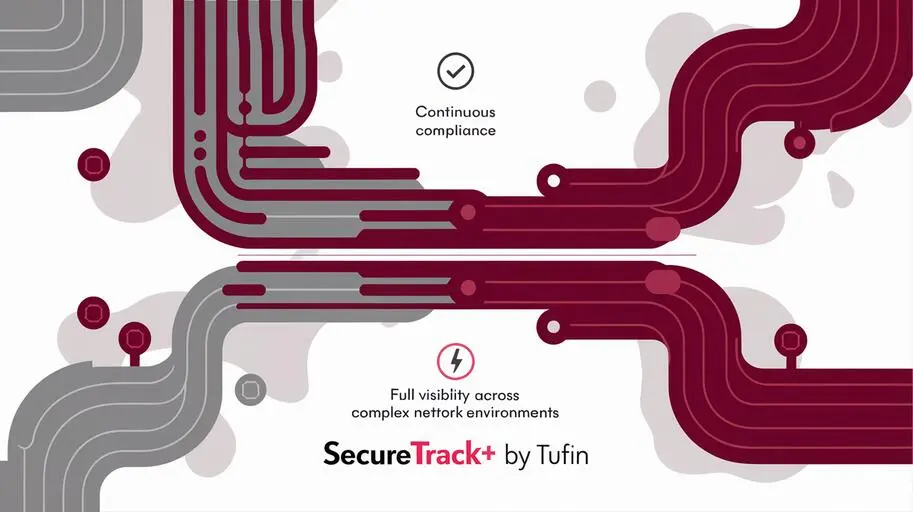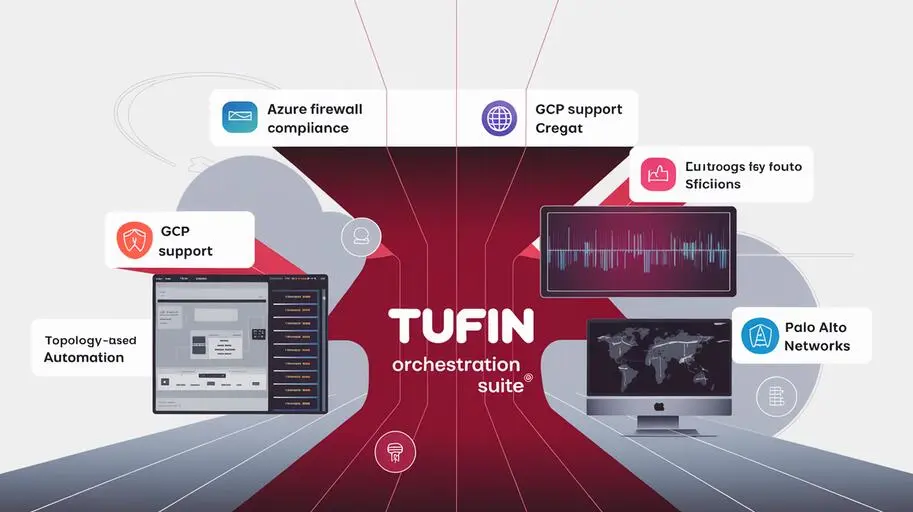
Tufin Cloud Application Protection: A Comprehensive Approach to Security
In today’s world, where companies are actively moving their applications and infrastructure to the cloud, security issues are of paramount importance. Traditional security methods are proving ineffective in dynamic and complex cloud environments. For example, manually configuring firewalls becomes almost impossible in the face of constant changes and scaling. Security teams often face challenges in meeting compliance requirements and effectively managing security policies in hybrid and multi-cloud environments. Tufin is a leading provider of network security policy management and automation solutions in hybrid cloud environments, offering a comprehensive approach to cloud application protection.
Tufin Solutions for Cloud Security: A Comprehensive Approach
Tufin provides a unified platform for managing security policies across your entire infrastructure, including cloud environments, traditional networks, and hybrid environments. The platform supports various types of security policies, such as access policies, microsegmentation, and compliance policies. This centralized approach allows organizations to gain a complete view of the security posture, automate key processes, and minimize risks.
Key Tufin Capabilities for Cloud Application Protection
- Discovery and visualization of cloud infrastructure: Tufin uses cloud provider APIs (AWS CloudTrail, Azure Activity Log, GCP Cloud Logging) to automatically discover and display cloud resources. The platform collects metadata, tags, and resource configuration, allowing administrators to gain a complete view of the network topology and interconnections between components. Configuration of the scanning frequency and filtering of resources by tags and regions is supported.
- Security policy management: Tufin allows you to create security policies based on security zones and objects, and then apply them to various platforms (AWS Security Groups, Azure Network Security Groups, GCP Firewall Rules). The platform converts policies into native formats for each platform, ensuring consistency and adherence to best practices. For example, you can create a policy that denies access to a specific port from the external network and apply it to all cloud platforms.
- Automation of security change management: Tufin automates the process of making changes to security policies using a ticketing system and workflow. Change requests go through an approval process, after which Tufin automatically applies the changes to the corresponding devices and platforms. All changes are logged and available for audit. For example, you can configure automatic creation of a ticket in ServiceNow when a security policy non-compliance is detected.
- Risk analysis: Tufin performs risk analysis based on configuration data, network traffic, and vulnerabilities. The platform identifies non-compliant configurations (e.g., open ports, insecure firewall rules), vulnerable software versions, and other risks. Risks are prioritized based on their potential impact and likelihood of exploitation, helping security teams focus on the most critical issues.
- Compliance: Tufin provides policy templates and reports for compliance with PCI DSS, HIPAA, GDPR, SOC 2, and other standards. The platform automates compliance auditing and monitoring, simplifying the demonstration of compliance. For example, you can automatically generate a PCI DSS compliance report based on network configuration data and security policies.
How Tufin Ensures Cloud Application Protection: Technical Details
Let’s take a closer look at the technical aspects of Tufin’s operation to ensure the security of cloud applications.
Tufin Integration with Cloud Platforms
Tufin uses the AWS API (Security Token Service, EC2 API, VPC API), Azure (Resource Manager API, Network API), and GCP (Compute Engine API, Cloud Networking API) to collect data on configuration, network traffic, and security policies. The platform supports various authentication methods, including API keys, service accounts, and managed identities. This allows Tufin to obtain up-to-date information about the state of the cloud infrastructure and effectively manage security policies.
Security Policy Management in a Hybrid Cloud Environment
Tufin abstracts security policies from specific technologies and platforms, allowing administrators to define policies in a single format. The platform automatically converts these policies into native configurations for each platform, ensuring consistency and simplifying management in a hybrid environment. This allows, for example, to create a policy requiring data encryption during transmission, and Tufin will automatically ensure its application in AWS, Azure, and on-premise infrastructure.
Security Automation: Security as Code with Tufin
Tufin allows you to define security policies in YAML format and integrate them into CI/CD processes. The platform provides plugins for Terraform, Ansible and other infrastructure-as-code tools, allowing you to automate the deployment and management of security policies in the cloud. For example, you can use Terraform to create new AWS Security Groups with pre-defined rules managed through Tufin.
version: “1.0”
name: “allow-web-traffic”
description: “Allow web traffic to the application”
rules:
– source: any
destination: web_application
service: http
action: allow

Security Change Management: Risk Prevention
Tufin monitors changes in the configuration of the cloud infrastructure (e.g., changes in firewall rules, changes in IAM roles, creation of new resources) using event logs and cloud provider APIs. The platform analyzes these changes and identifies potential risks, such as deviations from security policies, violations of regulatory requirements, and new vulnerabilities. For example, when creating a new S3 bucket without encryption, Tufin will automatically notify the administrator of a policy violation.
Risk and Vulnerability Analysis: Threat Detection and Prioritization
Tufin uses vulnerability databases (e.g., National Vulnerability Database, Common Vulnerabilities and Exposures) and vulnerability scan results to identify potential threats in the cloud infrastructure. The platform analyzes configuration, network traffic, and event logs to determine the severity of threats and provide recommendations for their elimination. For example, upon detecting a vulnerable version of Apache Tomcat, Tufin will suggest updating the software and blocking suspicious traffic.
Solving Specific Problems with Tufin: Practical Aspects
Let’s consider examples of solving specific security tasks with Tufin.
Protecting Web Applications in Kubernetes
Tufin integrates with Kubernetes through the API and allows you to manage Network Policies for microsegmentation of containers. The platform also supports Pod Security Policies configuration validation and protects ingress controllers through WAF integration. This allows, for example, to create a Network Policy that allows access to the database only from specific microservices.
Migration to the Cloud: Safe Transition
Tufin helps organizations assess risks during cloud migration by analyzing the current configuration of the on-premise infrastructure and identifying inconsistencies with security policies. The platform automatically applies security policies to new resources in the cloud, ensuring compliance from the moment of deployment. This allows, for example, to automatically transfer firewall rules from the existing on-premise infrastructure to AWS Security Groups.
Ensuring PCI DSS Compliance
Tufin helps organizations comply with PCI DSS requirements in the cloud by automating security audit and access management processes. The platform helps meet requirements for network segmentation (PCI DSS 1.2.1, 1.3.2), access management (PCI DSS 7.1, 8.1), and security monitoring (PCI DSS 10.1, 10.5). Tufin provides PCI DSS compliance reports and automates configuration verification to meet standards. For example, you can automatically generate a report showing compliance with PCI DSS requirements for access control to credit card data.
Security Incident Management
Tufin integrates with ITSM systems (e.g., ServiceNow, Jira) via API and automatically creates tickets when a security incident is detected. The platform provides information about network traffic, configuration, and vulnerabilities, helping security professionals investigate incidents and take corrective action. For example, upon detecting suspicious traffic, Tufin will automatically create a ticket in ServiceNow with information about the IP address, port, and potential threat.
Benefits of Using Tufin
Key benefits of using Tufin to protect cloud applications:
- Centralized Management: A single platform for managing security policies across all cloud and on-premise environments.
- Automation: Automation of change management and incident response processes to improve efficiency and reduce risks.
- Compliance: Automated reports and policies for compliance with PCI DSS, HIPAA, GDPR, and other standards.
Tufin provides a comprehensive solution for protecting cloud applications, allowing organizations to safely and effectively leverage the power of the cloud. Through automation, centralized management, and integration with other tools, Tufin helps reduce risks, improve efficiency, and ensure compliance.
Contact us for a personalized consultation, demo, or quote.
FAQs on: Protecting Cloud Applications with Tufin
-
What is Tufin and how does it help in securing the cloud?
Tufin is a unified platform for managing security policies in hybrid and multi-cloud environments. It provides a centralized view of the security posture, automates security processes, and minimizes risks.
-
What are the main features Tufin offers for protecting cloud applications?
Tufin offers cloud infrastructure discovery and visualization, centralized security policy management, security change management automation, risk and vulnerability analysis, and support for various compliance standards.
-
With which cloud platforms does Tufin integrate?
Tufin integrates with leading cloud platforms such as AWS, Azure, and GCP through APIs and native tools, allowing the platform to access information about cloud infrastructure configuration.
-
How does Tufin help manage security policies in a hybrid cloud environment?
Tufin provides centralized security policy management through a single pane of glass, allowing administrators to define policies that apply to all parts of the infrastructure, whether hosted in the cloud or on-premises.
-
What is Security as Code and how does Tufin support this concept?
Security as Code is an approach that allows organizations to define security policies as code. Tufin supports this concept by allowing you to automate the deployment and management of security policies, as well as integrate them into CI/CD processes.
-
How does Tufin ensure security change management?
Tufin tracks all changes in cloud infrastructure configuration and security policies, allowing you to identify potential risks and prevent unauthorized changes.
-
How does Tufin help protect web applications in Kubernetes?
Tufin automates security policy management for containers and microservices in Kubernetes, allowing organizations to deploy secure applications and effectively manage microservices.
-
How does Tufin help with cloud migration?
Tufin helps organizations assess risks and ensure compliance with security policies during migration to the cloud, allowing you to visualize the network topology and security policies, as well as automate the deployment of security policies in the cloud.
-
How does Tufin help organizations comply with PCI DSS requirements?
Tufin automates security audit and access management processes, and provides the reports and tools necessary to demonstrate compliance with PCI DSS requirements.
-
What are the main benefits of using Tufin to protect cloud applications?
Key benefits include improved security, process automation, cost reduction, standards compliance, and improved control over the security posture of the entire infrastructure.




